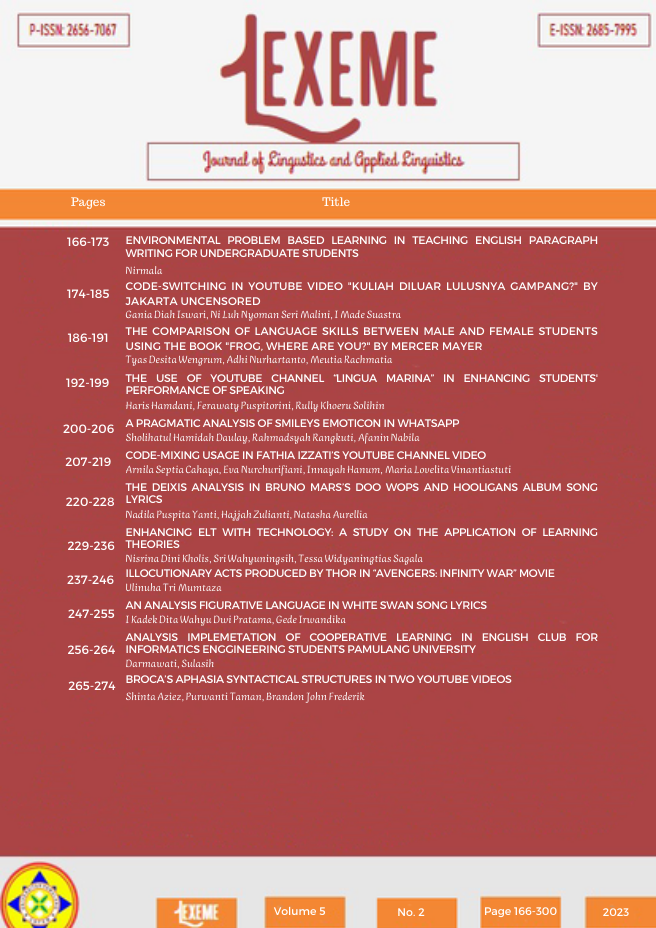ENHANCING ELT WITH TECHNOLOGY: A STUDY ON THE APPLICATION OF LEARNING THEORIES
DOI:
https://doi.org/10.32493/ljlal.v5i2.30566Keywords:
behaviourism theory, language instruction, technologyAbstract
In this era, many people worldwide have started using technology daily because it saves time and effort. This research investigates the application of learning theories in SMA Adiguna Bandar Lampung and how they are utilized in English language learning through technology. The descriptive qualitative method is employed in this study. To collect data, the researchers interviewed four SMA Adiguna Bandar Lampung teachers. Thematic data analysis was used to analyze the research findings. The results indicate the presence of behaviourism and cognitivism learning theories in SMA Adiguna Bandar Lampung; however, they are not integrated with technology. The researchers recommend further research with a broader scope and more participants. Therefore, educators can design effective instruction that supports learners in achieving their learning goals by applying appropriate learning theories.
References
Alakrash, H. M., Razak, N. A., Khalaf, I., Ogudo, K. A., & Mezhuyev, V. (2021). Technology-Based Language Learning: Investigation of Digital Technology and Digital Literacy. Sustainability 2021, Vol. 13, Page 12304, 13(21), 12304. https://doi.org/10.3390/SU132112304
Bada, S., Education, S. O.-J. of R. & M. in, & 2015, undefined. (n.d.). Constructivism learning theory: A paradigm for teaching and learning. Academia.Edu, 3(2), 2000. Retrieved May 9, 2023, from https://www.academia.edu/download/54094559/Constructivism.pdf
Blau, I., Shamir-Inbal, T., & Avdiel, O. (2020). How does the pedagogical design of a technology-enhanced collaborative academic course promote digital literacies, self-regulation, and perceived learning of students? The Internet and Higher Education, 45, 100722. https://doi.org/10.1016/J.IHEDUC.2019.100722
Braun, V., Clarker, V., & Rance, N. (2014). How to use thematic analysis with interview data. In A. Vossler & N. Moller (Eds.), The Counselling & Psychotherapy Research Handbook, (pp. 183–197). Sage.
Duffy, T. M., Jonassen, D. H., & Cole, Peggy. (2013). Evaluating Constructivistic Learning. 137–148. https://doi.org/10.4324/9780203461976-16
Glaser, B. G., & Strauss, A. L. (2017). Discovery of grounded theory: Strategies for qualitative research. Discovery of Grounded Theory: Strategies for Qualitative Research, 1–271. https://doi.org/10.4324/9780203793206
Gualtieri, S., Science, A. F.-P. on P., & 2022, undefined. (2022). The sweet spot: when children’s developing abilities, brains, and knowledge make them better learners than adults. Journals.Sagepub.Com, 17(5), 1322–1338. https://doi.org/10.1177/17456916211045971
Hastomo, T., & Septiyana, L. (2022). The Investigation of Students’ Engagement in Online Class During Pandemic Covid-19. Jurnal Penelitian Ilmu Pendidikan, 15(2). https://doi.org/10.21831/JPIPFIP.V15I2.49512
Henrie, C. R., Halverson, L. R., & Graham, C. R. (2015). Measuring student engagement in technology-mediated learning: A review. Computers & Education, 90, 36–53. https://doi.org/10.1016/J.COMPEDU.2015.09.005
Kessels, U., & Van Houtte, M. (2021). Side effects of academic engagement? How boys’ and girls’ well-being is related to their engagement and motivational regulation. Https://Doi.Org/10.1080/09540253.2021.2011840, 34(6), 627–642. https://doi.org/10.1080/09540253.2021.2011840
Loderer, K., Pekrun, R., & Lester, J. C. (2020). Beyond cold technology: A systematic review and meta-analysis on emotions in technology-based learning environments. Learning and Instruction, 70, 101162. https://doi.org/10.1016/J.LEARNINSTRUC.2018.08.002
Muhammad Nawaila, Sezar Kanbul, & Radwan Alhamroni. (2020). Technology and english language teaching and learning: a content analysis. Journal of Learning and Teaching in Digital Age, 5(1), 16–23.
Peel, K. L. (2020). A Beginner’s Guide to Applied Educational Research using Thematic Analysis. Practical Assessment, Research, and Evaluation, 25(1), 2. https://doi.org/https://doi.org/10.7275/ryr5-k983
Piaget, J. (1977). The development of thought: Equilibration of cognitive structures. Viking.
Rao, Z. (2012). Language learning strategies and English proficiency: interpretations from information-processing theory. Https://Doi.Org/10.1080/09571736.2012.733886, 44(1), 90–106. https://doi.org/10.1080/09571736.2012.733886
Skinner, B. F. (1935). The Generic Nature of the Concepts of Stimulus and Response. The Journal of General Psychology, 12(1), 40–65.
Struyf, A., De Loof, H., Boeve-de Pauw, J., & Van Petegem, P. (2019). Students’ engagement in different STEM learning environments: integrated STEM education as promising practice? Https://Doi.Org/10.1080/09500693.2019.1607983, 41(10), 1387–1407. https://doi.org/10.1080/09500693.2019.1607983
Suhendi, A., & Purwarno. (2018). Constructivist Learning Theory: The Contribution to Foreign Language Learning and Teaching. KnE Social Sciences, 3(4), 87–95–87–95. https://doi.org/10.18502/KSS.V3I4.1921







